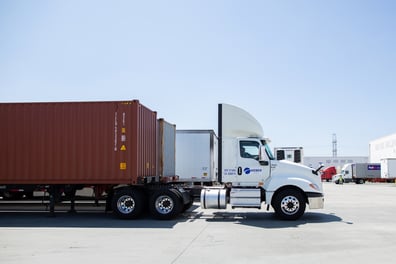As we examined in our recent blog post on port congestion, ports across the U.S. – most notably the Ports of Los Angeles and Long Beach – are experiencing severe backups due to increased import activity after the initial pandemic-related slowdown of 2020. The effects of these backups continue to be felt throughout the supply chains of importers. In this article, we focus on one piece of this port congestion puzzle: the West Coast chassis pools, specifically those at the Ports of LA and Long Beach.
3 West Coast chassis pool challenges at Ports of L.A. and Long Beach
 With severe port congestion at the Ports of L.A. and Long Beach, there aren’t enough chassis to handle current volumes. There are three reasons for this.
With severe port congestion at the Ports of L.A. and Long Beach, there aren’t enough chassis to handle current volumes. There are three reasons for this.
1. The first is the congestion itself. In March 2021, chassis dwell time (or “street dwell time”) is currently 7 days, meaning that each chassis rented from the a chassis pool at the Ports is not returned for about a week. Imported containers are backed up at every step of the import supply chain, up to and including the warehouse. Local warehouses are swamped, and goods are coming into the warehouse much faster than they are leaving. The result is a pile up of containers and chassis in warehouse yards (and overflow lots), where these commodities sit idle instead of being unloaded and put back into circulation.
2. The second issue is that the Ports of L.A. and Long Beach – and its terminals – are allotting most appointment slots for dual transactions and allowing for very few single transaction appointments. With a dual transaction, a drayage provider drops off a container and receives a new container at the same terminal. Dual transactions help to speed the drayage process at the Port and are thus favored by the terminals and by drayage providers.
With single transactions, on the other hand, the drayage provider drops off a container at a terminal but needs to pick up a container at a different terminal. As this is not allowed during the majority of the Ports’ appointments, drayage providers simply must wait for a hard-to-come-by single transaction appointment or wait until their business allows for a dual transaction. Either way, this waiting results in more chassis sitting idle instead of being put back into circulation.
3. The third issue involves new (within the last 6 months) Port rules regarding which chassis can be used at a given terminal. The Ports of Los Angeles and Long Beach have one giant chassis pool, the “Pool of Pools,” in which the Ports’ three largest chassis companies – DCLI, TRAC and Flexi-Van – share chassis rental responsibilities. Under the new rules, terminals are only allowing visits from trucks with specific chassis during designated time periods.For example, let’s say you have a container going back to Maersk but you’re using a FlexiVan chassis. After your driver drops off the container at the Maersk terminal, he or she would like to pick up a container at Pier A. However, Pier A is only accepting TRAC chassis at that time. In this case, the driver would have to return the FlexiVan chassis back to rental pool, wait to rent a TRAC chassis and then head over to Pier A. These extra steps are time consuming and result in drivers handling fewer containers each day.
How to navigate West Coast chassis pool challenges
While there are no easy answers to securing chassis and moving containers during this period of port congestions, there are some things that you can do to improve your odds of success.
Partner with an asset-based carrier for drayage. An asset-based drayage carrier owns its equipment, including chassis, and will allocate that equipment to its customers’ shipments. Now, of course, not every asset-based carrier is going to have equipment available as it may be “spoken for” by other customers. But, once you find one that can accommodate you, the equipment is locked in as yours. The only exception, unfortunately, is times like these where congestion is so great that their chassis are tied up. When this occurs, even asset-based drayage carriers will need to turn to the chassis pools for reinforcements.
Partner with a drayage provider with an automated appointment system. During situations like these, terminal appointments at the Ports are very difficult to come by. If your drayage provider has an automated system for checking terminal appointments, however, you can greatly improve your chances of getting an appointment slot as soon as one becomes available.
Consider wheeled container steamship service. Steamship lines offer “wheeled container” service in which you pay for both a container and the chassis. The big upside here is that the line is committed to providing you with a chassis. So, even if the steamship line can’t procure a chassis for you right away, it will not charge you demurrage or per diem while your container sits at the port.
Turn to Weber to offset West Coast chassis pool challenges
Weber Logistics is a California-based 3PL that performs drayage operations at all major CA ports as part of our integrated logistics offering, which combines port services with transportation and warehousing. This integrated approach allows you to work with one 3PL for your West Coast supply chain needs. Weber is also asset-based, with its own trucks and equipment to get your goods from port to market faster. To learn more about our services, contact Weber Logistics today.






 Capital Management
Capital Management